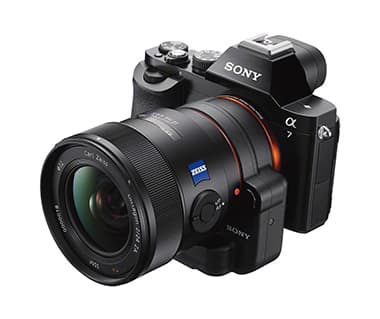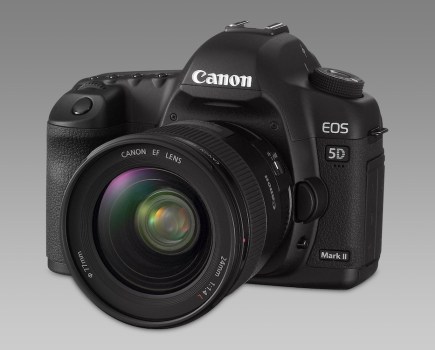Sony Alpha 7 & Alpha 7R at a glance
- 36.4MP (A7R) and 24.3MP (A7) full-frame CMOS sensors
- 3in, 921,600-dot tilting screens
- 2.36-million-dot EVF
- Wi-Fi and NFC
- RRP £1,300 (A7) and £1,600 (A7R) body only

After the release of the Sony Cyber-shot DSC-RX1 full-frame compact camera, rumours of a full-frame Sony compact system camera began to surface. Now, after much anticipation, two new full-frame CSCs – the Alpha 7 and Alpha 7R – have been released.
Sony Alpha 7 & Alpha 7R – Features
The most important feature of these two new cameras is their sensors. The Sony Alpha 7R has an extremely impressive 36.4-million-pixel, full-frame sensor, no doubt similar to that used in the Nikon D800. However, Sony claims it is a newly developed ‘gapless’ design with no space between the micro lenses. These micro lenses focus the light reaching the sensor onto the photodiodes, so this should help to improve dynamic range and noise levels.
The gapless micro lenses are also arranged in such a way as to aid light gathering and the sharpening of images at the very edges of the frame. This is essential as the E mount has a very short back-focus distance – there is just 18mm between the lens mount and sensor – so light will reach the sensor from an extremely shallow angle, particularly for a full-frame unit.
To get the maximum possible resolution from the Alpha 7R’s 36.4-million-pixel sensor, Sony has decided not to use an anti-aliasing filter. The result is that the Alpha 7R should have a higher-than-average ability to resolve detail. Although the sample we saw was a pre-production model, and we weren’t able to take any images with it, comparisons can be drawn with the Nikon D800E. The Nikon DSLR also has a 36.4-million-pixel sensor, but includes a second anti-aliasing filter that negates the effects of the first, producing a similar effect to it having no anti-aliasing filter at all. If the Alpha 7R could match the performance of the D800E, yet in a much smaller body, it could prove very popular among landscape and studio photographers – something compact system cameras have so far failed to achieve.

Sony’s other new model, the Alpha 7, is targeted at a slightly different audience. While still full frame, the sensor has 24.3 million pixels. It features the same 25 contrast-detection AF points as the Alpha 7R, but this time combines them with 117 on-sensor, phase-detection AF points. Sony is calling this system Fast Hybrid AF.
Like Sony’s entry-level Alpha 3000 that we reviewed in AP 5 October, both the Alpha 7 and 7R seem to focus very quickly. The contrast-detection AF in the Alpha 7R is very snappy, with the Fast Hybrid AF of the Alpha 7 even quicker. Sony was keen to point out that in certain shooting conditions, and used with certain lenses, both cameras could actually focus faster than a range of high-end DSLRs. My initial impression of the two focusing systems is very positive, although I will wait to see how the two cameras handle tougher, dark conditions and moving subjects before drawing any conclusions.
Both models are fitted with a new Bionz X processing system. The company claims this to be around three times faster than the previous Bionz system. In combination with the full-frame sensors, this new processor allows for a sensitivities of between ISO 50 and 25,600 to be selected.
Like most new cameras, the Alpha 7 and 7R have built-in Wi-Fi and NFC (Near Field Communication) to allow remote shooting and image transfer to a smartphone or tablet, via the Sony Play Memories app.
Sony Alpha 7 & Alpha 7R – LCD and viewfinder

Both cameras have 3in, 921,600-dot tilting screens – but more importantly, they each have a 2,359,296-dot electronic viewfinder. I found the EVF to be clear and bright with a very fast refresh rate. In fact, it is so ‘realistic’ that it is easy to convince yourself that you are looking at an optical display. It certainly performed well given that I was using a pre-production camera.
Sony Alpha 7 & Alpha 7R – Build and handling
The body shared by the two cameras has the same understated aesthetic qualities as the firm’s own Cyber-shot DSC-RX1 and DSC-RX100 compact cameras, although this does leave them looking somewhat unremarkable. However, underlying the Alpha 7R’s premium status is a weather-sealed, magnesium-alloy body; the Alpha 7 is built from a combination of magnesium and polycarbonate.
In the hand, the cameras feel strong and sturdy, with a substantial handgrip that supports the larger Alpha-mount lenses. Using the Alpha 7R with the new 70-200mm f/2.8 G SMM II lens, the camera felt a little unbalanced – this is obviously a large lens to be putting on a small camera – but it was certainly usable. A new vertical battery grip is also available, which worked nicely when shooting portraits and helped balance the camera when I used it with larger A-mount lenses.
Both cameras have nine customisable buttons and 46 assignable features to give photographers access to those they use the most. Sony has clearly learned from the initial NEX models, which had too few buttons.
Sony Alpha 7 & Alpha 7R – Lens mount

Although the new Alpha 7 and 7R use the existing Sony E mount, to take full-resolution images they will have to be fitted with new full-frame E-mount lenses, marked ‘FE’. At the launch event there were FE 28-70mm f/3.5-5.6 OSS, Sonnar T* FE Zeiss 35mm f/2.8 ZA and Zeiss Sonnar T* FE 55mm f/1.8 ZA lenses available. A Zeiss Vario-Tessar T* FE 24-70mm f/4 ZA OSS lens will arrive later, along with a 70-200mm f/4 G OSS optic. A macro, a wideangle and another wide-aperture prime lens are also in the pipeline for release towards the middle of 2014.
Sony Alpha 7 & Alpha 7R – Lens adapters
All existing E-mount lenses can be mounted and will work on the Alpha 7 and 7R, although they won’t be able to make full use of the sensor. Instead, they will produce 10-million-pixel and 16-million-pixel cropped images respectively. Owners of Sony A-mount lenses will be able to use adapters to mount their lenses on the new cameras. The new LA-EA3 and LA-EA4 lens adapters are the equivalents of the LA-EA1 and LA-EA2 adapters for NEX cameras. The LA-EA3 is a standard tube adapter, while the LA-EA4 features a pellicle mirror and an AF motor.

I used the Alpha 7R with the LA-EA4 adapter and a few Alpha-mount lenses and the combination worked well. The adapter adds phase-detection AF to the camera, and it felt as fast to use as a Sony Alpha SLT. I even tried it with the new 70-200mm f/2.8 G SMM II lens and the focusing seemed quick enough for sports and wildlife photography. We hope to be able to test the speed of the A-mount lenses when using both adapters in a full test in the coming weeks. What is interesting is that by using the adapters, existing Alpha users already have a range of lenses they can use on the Alpha 7 and 7R, and when using the LA-EA4 adapter, the performance should be equal to, if not better than when using their Alpha DSLR.
Sony Alpha 7 & Alpha 7R – First impressions
Based on the sensor resolution and AF speed, the Sony Alpha 7 and 7R are very appealing. If the final image quality and AF live up to expectations, then these two lightweight and extremely portable Alpha cameras should be popular among landscape and travel photographers. The lighter and smaller bodies of these full-frame models will be less of a strain when travelling long distances, and will suit documentary and street photographers who seek premium image quality and an inconspicuous build.
The Nikon D600 and Canon EOS 6D both demonstrate that there is a market for small DSLRs with full-frame sensors, so the new Sony Alpha 7 and 7R could offer a genuine alternative.
The Sony Alpha 7 and Alpha 7R will be available from mid-late November, priced £1,300 (7) and £1,600 (7R) body only.







